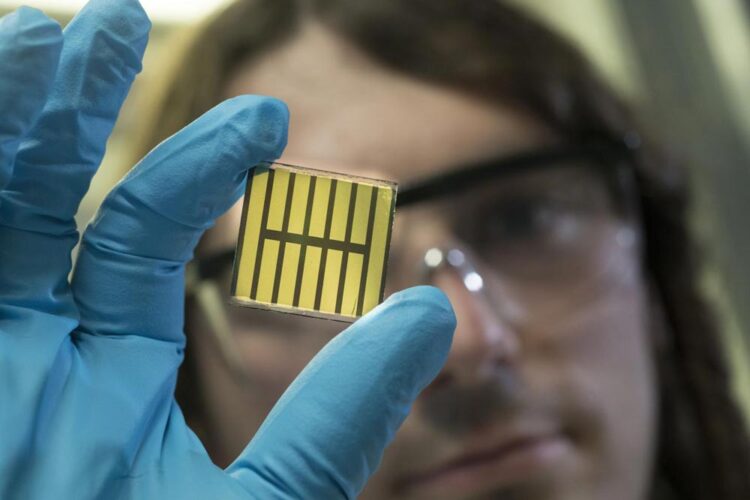Shedding light on perovskite films

In terms of efficiency, perovskite solar cells have caught up on silicon solar cells, but some of their properties are not yet understood completely.
Credit: Markus Breig, KIT
Efficient materials for future solar cells – New model to determine photoluminescence quantum efficiency.
Photovoltaics decisively contributes to sustainable energy supply. The efficiency of solar cells in directly converting light energy into electrical energy depends on the material used. Metal-halide perovskites are considered very promising materials for solar cells of the next generation.
With these semiconductors named after their special crystal structure, a considerable increase in efficiency was achieved in the past years. Meanwhile, perovskite solar cells have reached an efficiency of up to 25.5 percent, which is quite close to that of silicon solar cells that are presently dominating the market. Moreover, the materials needed for perovskite solar cells are rather abundant. The solar cells can be produced easily and at low cost and they can be used for various applications. The theoretically achievable efficiency of perovskite solar cells is about 30.5 percent.
To approach this value, optoelectronic quality of perovskite semiconductors must be further increased. In principle, materials suited for photovoltaics are expected to not only absorb light, but to also emit it efficiently. This process is known as photoluminescence. The corresponding parameter, photoluminescence quantum efficiency, is perfectly suited to determine the quality of perovskite semiconductors.
Together with scientists from the Center for Advanced Materials (CAM) of Heidelberg University and the Technical University of Dresden, researchers of KIT’s Institute of Microstructure Technology (IMT) and Light Technology Institute (LTI) have now developed a model, by means of which photoluminescence quantum efficiency of perovskite films can be determined reliably and exactly for the first time. Their results are reported in Matter.
Materials Have More Optimization Potentials than Assumed
“With the help of our model, photoluminescence quantum efficiency under solar irradiation can be determined far more precisely,” says Dr. Paul Fassl from IMT. “Photon recycling is of high importance. This is the share of photons emitted by the perovskite, which is re-absorbed and re-emitted in the thin films.” The researchers applied their model to methylammonium lead triiodide (CH3NH3PbI3), one of the perovskites of highest photoluminescence quantum efficiency. So far, it has been estimated to amount to about 90 percent. Model calculations, however, revealed that it is about 78 percent.
The scientists explain that previous estimations did not adequately consider the effect of light scattering and, hence, underestimated the probability of photons – the quantums of light energy – leaving the film before they are re-absorbed. “Our results show that the potential for optimization of these materials is far higher than assumed,” says Dr. Ulrich W. Paetzold, Head of the Advanced Optics and Materials for Next Generation Photovoltaics Group of IMT. The team offers an open-source application based on the model, by means of which photoluminescence quantum efficiencies of various perovskite materials can be calculated.
###
Original Publication
Paul Fassl, Vincent Lami, Felix J. Berger, Lukas M. Falk, Jana Zaumseil, Bryce S. Richards, Ian A. Howard, Yana Vaynzof, Ulrich W. Paetzold: Revealing the internal luminescence quantum efficiency of perovskite films via accurate quantification of photon recycling. Matter. Cell Press, 2021. DOI: 10.1016/j.matt.2021.01.019.
https:/
More about the KIT Energy Center: https:/
Contact for This Press Release
Sandra Wiebe, Press Officer, Phone: +49 721 608-41172, Email: sandra.wiebe@kit.edu
Being “The Research University in the Helmholtz-Association,” KIT creates and imparts knowledge for the society and the environment. It is the objective to make significant contributions to the global challenges in the fields of energy, mobility and information. For this, about 9,600 employees cooperate in a broad range of disciplines in natural sciences, engineering sciences, economics, and the humanities and social sciences. KIT prepares its 23,300 students for responsible tasks in society, industry, and science by offering research-based study programs. Innovation efforts at KIT build a bridge between important scientific findings and their application for the benefit of society, economic prosperity, and the preservation of our natural basis of life. KIT is one of the German universities of excellence.
All latest news from the category: Materials Sciences
Materials management deals with the research, development, manufacturing and processing of raw and industrial materials. Key aspects here are biological and medical issues, which play an increasingly important role in this field.
innovations-report offers in-depth articles related to the development and application of materials and the structure and properties of new materials.
Newest articles
Faster, more energy-efficient way to manufacture an industrially important chemical
Zirconium combined with silicon nitride enhances the conversion of propane — present in natural gas — needed to create in-demand plastic, polypropylene. Polypropylene is a common type of plastic found…

Energy planning in Ghana as a role model for the world
Improving the resilience of energy systems in the Global South. What criteria should we use to better plan for resilient energy systems? How do socio-economic, technical and climate change related…

Artificial blood vessels could improve heart bypass outcomes
Artificial blood vessels could improve heart bypass outcomes. 3D-printed blood vessels, which closely mimic the properties of human veins, could transform the treatment of cardiovascular diseases. Strong, flexible, gel-like tubes…





















